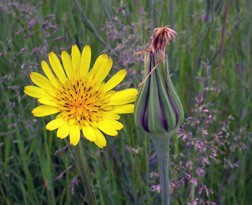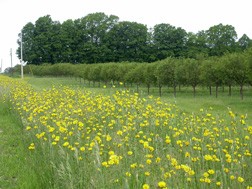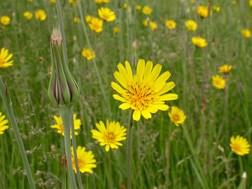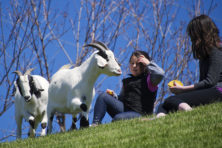Goats-beard is Here to Stay
- Share
- Tweet
- Pin
- Share

A single Goats-beard and a seed pod.
There is a tall, alien, yellow weed that decorates some roadsides by the thousands from mid to late June. As soon as you see the height of the plant, upwards of two to three feet, you immediately know that it isn’t a Dandelion. Realizing that so many weeds go by various names, often handed down from generation to generation, you might call it Morning Sun, Noon Flower, Star-of-Jerusalem or Meadow Salsify. Many refer to it as Goats-beard, a name that takes on some meaning after the beautiful, globular, three to four-inch-wide seed head has formed resembling an oversized Dandelion cluster of seeds.
Some years ago Charlotte and I put together a colored slide program called “Weeds, Villainous Vagabonds,” and taking the many pictures put me at perfect ease because one doesn’t have to be especially careful to not step on the weeds.
Recently, I waited for a few hours after sun-up before heading to a favorite roadside Goats-beard patch east of Egg Harbor on Harbor School Road to take pictures of this neat weed. I realized this plant is an excellent example of positive phototropism whereby it “obediently” faces the sun until around noon when it closes for the day. To see an entire patch of several thousand practically all facing in the identical direction is quite pleasing.
This is one weed we try to prevent from growing near our garden, something I learned from our friend Emma Toft a long time ago. She detested this plant along with other weeds such as Orange Hawkweed and Spotted Knapweed. Once the plant goes to seed the tiny parachutes will travel far and wide.
Its scientific name is Tragopogon (trag-o-PO-gon) dubius. In the Greek language “tragos” means goat, and “pogon” refers to a beard, while “dubius” means doubtful. Proper identification of the young second-year plant is challenging and doubtful leading to its “dubius” name. Examine the silky texture of a fully developed seed head and you should easily be able to visualize a goat’s beard.

Hundreds of Goats-beard flowers face the sun at 9 am.
Surely some of you have never eaten the garden vegetable, Salsify. Other common names are Oyster Plant, Oyster Vegetable and Oyster Root due to their similarity of flavor. The plant has a long, cylindrical, fleshy root looking somewhat like a small Parsnip. Those who grow and eat them claim that, when properly cooked, they are wholesome and have a very delicate flavor. Left to grow a second year the plant produces lovely purple flowers and eventually seeds that can spread far and wide.
The wild Goats-beard of this area is a biennial with grass-like leaves clasping the stem. The first year plant forms a broad rosette, escapes the blades of the roadside mowers, and gets the second-year plant off to a very early start in spring. If you are interested in experimenting with the edibility of the plant, the time to dig out the roots is when the new second year plant is just beginning to form a small stem close to the ground. The white milky juice of that portion of the plant above the ground is very bitter, making it unpalatable to livestock. My suggestion is let them continue growing in the wild. Forget about trying to eat them.
Several years ago we examined one of the exquisitely geometrical globular seed heads and naturally found it to be quite intricate and beautiful. The head was about four inches wide and had a total of 92 seeds, each resembling a fascinating little parachute. Each parachute was approximately two inches across, had 30 rays, like those of an umbrella, and thousands of silky strands intricately woven between the rays. Talk about marvelous engineering in nature. How slowly and gently they floated to the floor as we lifted them above our heads and released them. Over and over! What fun!

Excellent “packaging” of Goats-beard seeds in its vase-shaped seed pod.
Every parachute supports a 1¼-inch-long seed that has tiny barbs pointing back toward the parachute so that wind action, once the seed has landed, will continue working and twisting the seed downward into contact with the soil.
Beware of spraying the seed-heads with a fixative, such as hair spray, or with colored spray paint. Granted they can become attractive centerpieces, but you also run the risk of discarding them and inadvertently spreading these seeds and weeds into another area.
The Goats-beard really is a lovely plant to admire in spite of its amazing ability to parachute its seeds to new and fertile ground. As fast as I mention certain weeds being alien invaders I am reminded of my great grandparents who, in 1856, also came to this country from across the Atlantic Ocean. And so we admire the eye-catching qualities of the Goats-beard and concede that they too are here to stay. Enjoy them!


